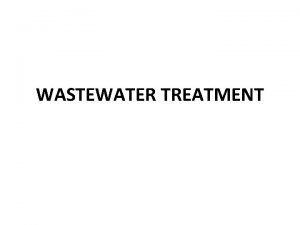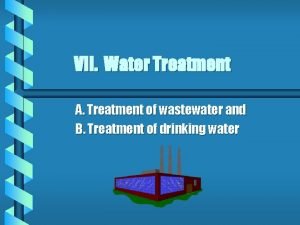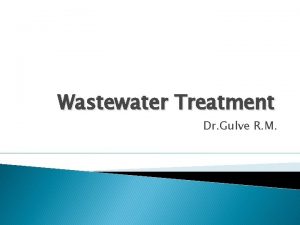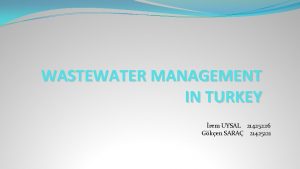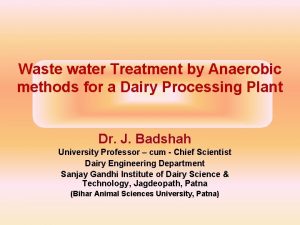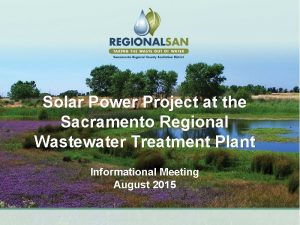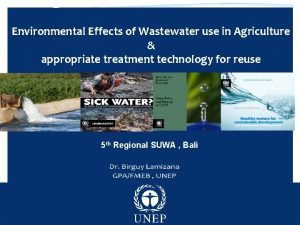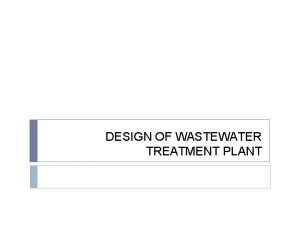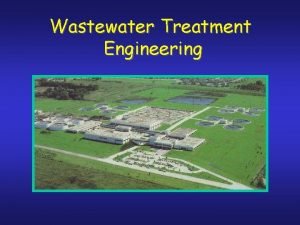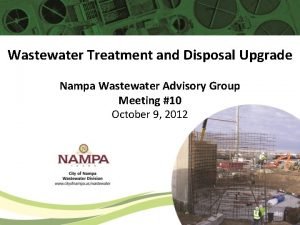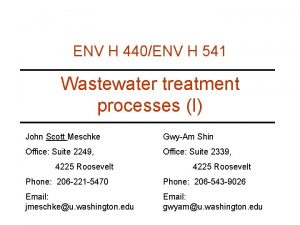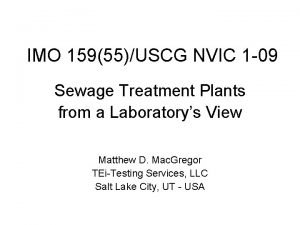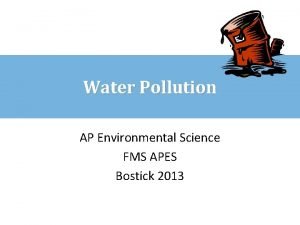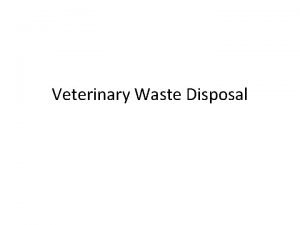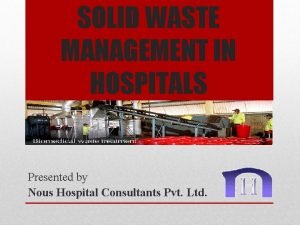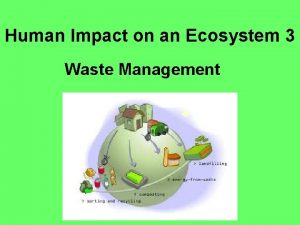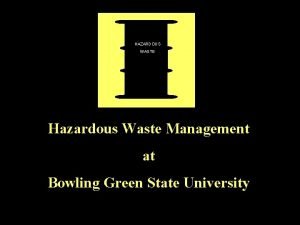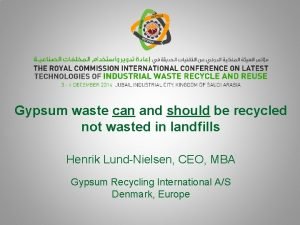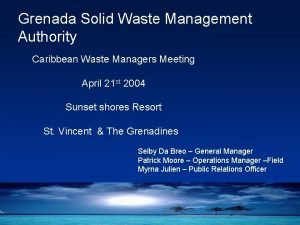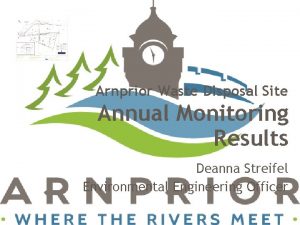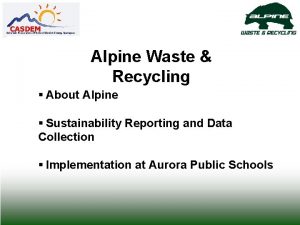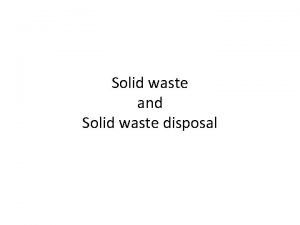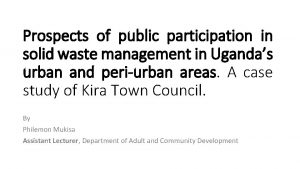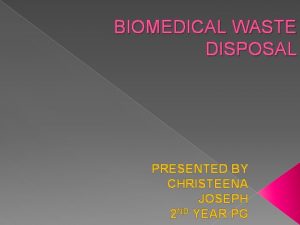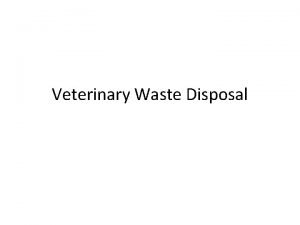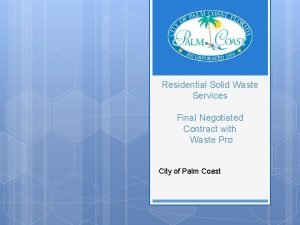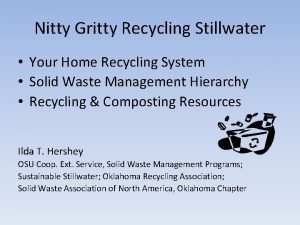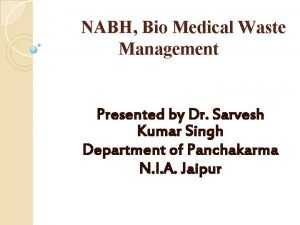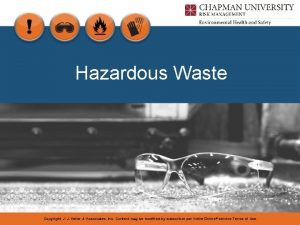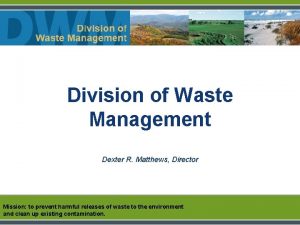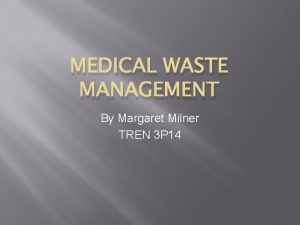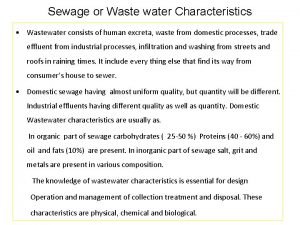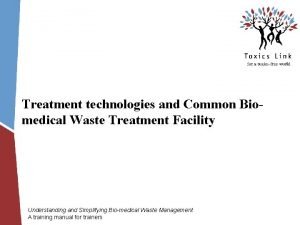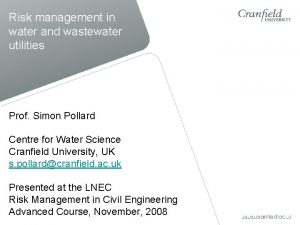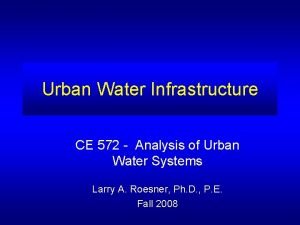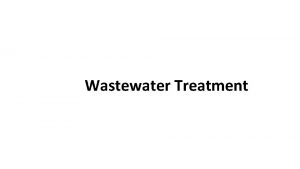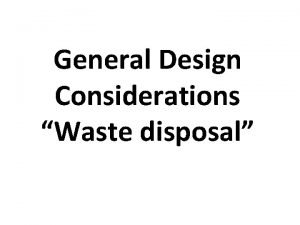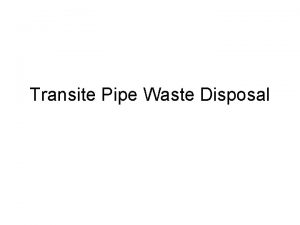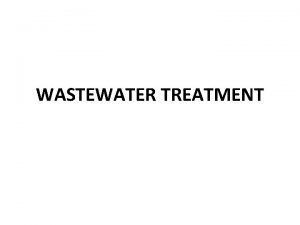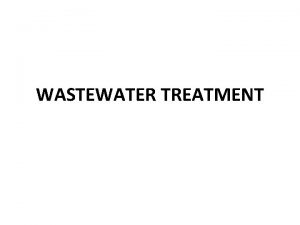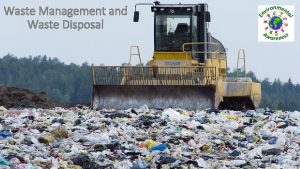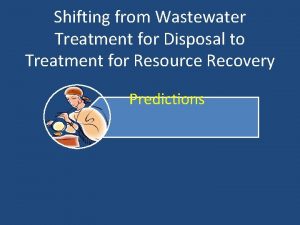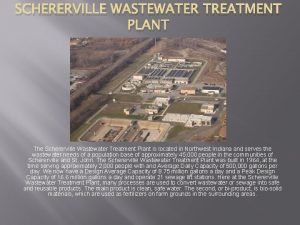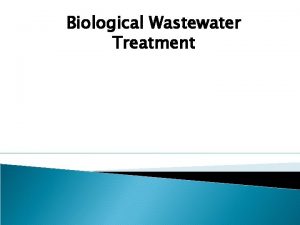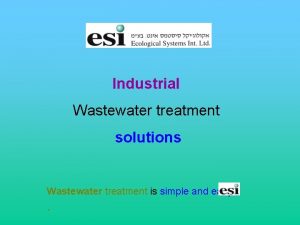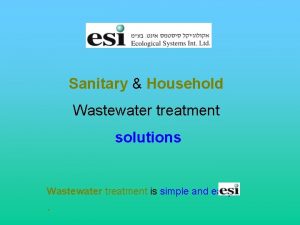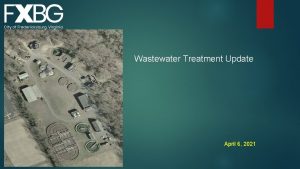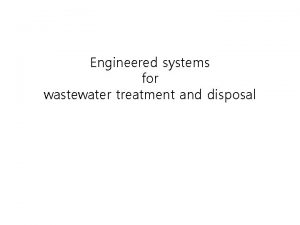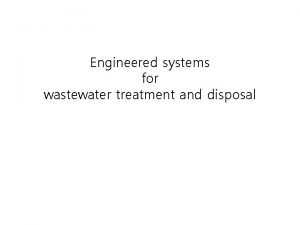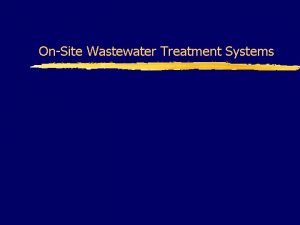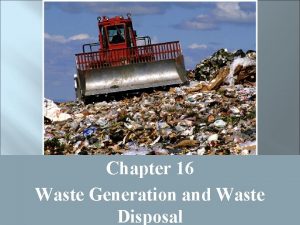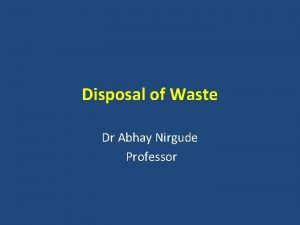Wastewater Treatment Characteristics and Systems DISPOSAL OF WASTE












































- Slides: 44

Wastewater Treatment: Characteristics and Systems

DISPOSAL OF WASTE MATERIAL ON LAND WATER BODIES Liquid wastes may be disposed of in a number of ways (before giving at least secondary level treatment). • Surface waters (Rivers, Lakes etc) • On land DISPOSAL IN SURFACE WATERS In natural streams, there is a balance between plant and animal life, with considerable interaction among the various life forms. Waters of good quality are characterize by multiplicity of species with no dominance.

Organic matter which enters the stream is broken down by bacteria to ammonia, nitrates, sulfates, carbon dioxide etc, which are used by plants and algae to produce carbohydrates and oxygen.

Water Pollution Introduction of excessive quantities of waster material can upset the cycle by causing rapid bacterial growth and resulting depletion of dissolved oxygen in the stream. Polluted waters are characterized by very large number of relatively few species.

Disposal of Wastewater Disposal of wastewater in a stream should be thus regulated with respect to both quantity and concentration in order to safeguard the aquatic life and desirable water use. Thus there is a limit on the amount of liquid wastewater that can be disposed of in a water body, which is called the assimilative capacity of that water body.

ASSIMILATIVE CAPACITY Assimilative capacity can thus be defined as the amount of wastewater that can be disposed of in the water body and it can be safely stabilized while maintaining the desired water quality. Since a certain amount of wastewater can be discharged into a receiving water body, it may be highly un-economical to outlaw the wastewater discharge. However, excessive discharge will impair the stream water quality.

ON-LAND DISPOSAL OF WASTEWATER A treatment, at least to secondary level must be given prior to LAND DISPOSAL this is necessary due to the following reasons. 1. To reduce stress upon SOIL SYSTEM 2. To reduce production of NUISANCE CONDITIONS. Following methods may be employed for land disposal of wastewater. 1. SPRAY IRRIGATION 2. RAPID INFILTRATION 3. OVERLAND RUNOFF

Reuse of Treated Wastewater 1. Spray Irrigation: Treated sewage or waste water may be applied to both forests and agricultural lands. Care is however to be taken that the treated sewage MEET THE REQUIRED COLIFRIM AND BOD STANDARDS as employed for various irrigations uses.

Reuse of Treated Wastewater Rapid Infiltration. This is done either for Waste water disposal (e. g Soakage pits) Ground water recharge For GROUND WATER RECHARGE, wastewater is discharged into large basins UNDERLAIN BY SAND and soil of high permeability. The bottom of the basins is covered by BERMUDA GRASS to absorb NUTRIENTS.

Reuse of Treated Wastewater Overland Runoff / Flow It is not a true disposal system since the wastewater must be collected after passage over soil. This is in fact a method of TERTIARY TREATMENT of wastewater to further reduce its BOD and nutrient levels. The grasses are planted on the ground over which sewage flow.

USE OF TREATED SEWAGE FOR IRRIGATION All the HUMAN and Animals manure, which the world loses by discharging of sewage in to the RIVERS if returned to the land instead of being thrown into the sea, should suffice to nourish the world. (VICTOR HUGO 1868)

Advantages of Wastewater Irrigation Use of wastewater for irrigations has following advantages. • Prevention of river pollution and protection of surface water quality. • Conservation of water and nutrients to improve agriculture in arid and semi-arid regions.

HISTORY Use of raw wastewater for irrigation purpose can be traced back to 1880 s. U. K, France, Germany, Australia, Mexico practiced it. However in the beginning little considerations went into health hazards related with raw sewage irrigation containing pathogenic and parasitic organisms. After 1945, standards were set for the first time for wastewater to be used for irrigation. The interest in wastewater reuse gained momentum and in many countries concrete efforts were made in this direction e. g.

Examples of Wastewater Reuse • Khartoum : 2800 ha greenbelt was irrigated with treated wastewater. • Mexico City : and grain 100, 000 ha fodder irrigated with treated wastewater.

Scenario of Wastewater Irrigation in Pakistan In Pakistan, raw wastewater is used to irrigate 800 ha, 2000 ha and 2500 ha land in Lahore, Hyderabad and Faisalabad respectively. Although wastewater reuse has been practical more widely in developing countries over the past 30 years, much of it is UNPLANNED and UNCONTROLLED and possess a threat to public health. These risks must be fully understood and appropriate measures taken to provide TECHNICALLY FEASIBLE and ECONOMICALLY ATTRACTIVE solutions to that public can reap the full benefit of wastewater reuse without suffering harmful effects.

PUBLIC HEALTH RISK ASSOCIATED WITH RAW SEWAGE WASTE WATER The wastewater stream of a community carries full spectrum of pathogenic microorganisms excreted in the feces and urine of infected individuals. Their concentration is: • Many millions / liter for bacteria • Thousands / liter for viruses • Few hundred / liter for helminth eggs Most excreted pathogens can survive if the environment long enough to be transported by the wastewater to the fields.

Health risk is high for people using salads and vegetables EATEN UNCOOKED and irrigated with RAW SEWAGE. Such people are exposed to following diseases arranged in descending order of their chance of occurrence: – Helminthes (worm) disease – Cholera – Typhoid Similarly SEWAGE FARM WORKERS are also exposed to above diseases. However, evidence of bacterial and viral diseases among them is limited. There is no demonstrated risk to people close to sewage -irrigated sites.

Effective wastewater treatment Wastewater treatment process that effectively remove all, or most pathogens reduce the negative health effects caused by the utilization of wastewater for irrigation

ASPECT OF WASTE WATER REUSE Wastewater from a city of 500, 000 persons with 175 -lpcd water consumption can irrigate 2700 ha of land. wastewater effluent has a SIGNIFICANT FERTILIZER VALUE. It can supply all or more of the NITROGEN and much of the PHOSPHORUS and POTASSIUM required for agriculture crops. Furthermore, the organic matter in the effluent adds valuable MICRONUTRIENTS and HUMAS to the soil, which helps to improve WATER RETENTION capacity of soil.

Advantages of wastewater irrigation Studies in California, Portugal and Israel have shown that many crops can thrive under wastewater irrigation without any additional chemical fertilizer.

W. H. O GUIDELINES * Parameter Value Helminth Eggs ≤ 1 / liter Fecal Coliform ≤ 1000 / 100 ml * for irrigation of crop likely to be eaten uncooked, sports fields, public parks Mmicronutrients: Very small quantity of certain substances are required for crops. E. g. Mn, Fe etc.

Significance of Wastewater Contaminants • Suspended solids – can cause sludge deposits and anaerobic conditions in the environment • Biodegradable organics – can cause anaerobic conditions in the environment • Pathogens – transmit disease • Nutrients – can cause eutrophication • Heavy metals – toxicity to biota and humans • Refractory organics – toxicity to biota and humans • Dissolved solids – interfere with reuse

Characteristics of Domestic Wastewater

On-Site Disposal Systems • In locations where sewers and a centralized wastewater treatment system are not available, on site disposal must be used • Septic systems most common for individual residences • “Engineered systems” used for unfavorable site conditions • Larger systems required for housing clusters, rest areas, commercial and industrial facilities

Septic Systems

Septic Systems Septic Tank – settling, flotation and anaerobic degradation

Septic Systems Drain field (cross-section) – aerobic degradation

Septic Systems • Soil must pass percolation test – soil type – rate of water infiltration – depth to water table • Design specifications – Tank volume and number of chambers – Drain field size – Drain field materials • Basis for design is empirical • Tank must be “pumped” to remove solids every 1 -3 years • Drain field replacement may be required

Engineered Systems Mound System

Engineered Systems • Intermittent sand filter can be designed for – – pulsed dosing even distribution high treatment efficiency leakage protection



Municipal Wastewater Treatment Systems • Pretreatment – removes materials that can cause operational problems, equalization optional • Primary treatment – remove ~60% of solids and ~35% of BOD • Secondary treatment – remove ~85% of BOD and solids • Advanced treatment – varies: 95+ % of BOD and solids, N, P

Pretreatment of Industrial Wastewaters • Industrial wastewaters must be pretreated prior to being discharged to municipal sewer system • Approach is to remove materials that will not be treated by municipal system • Local authority must monitor and regulate industrial discharges • Pretreatment requirements set by U. S. EPA or by any other monitoring agency

Bar racks • Purpose – remove objects larger • Solid material stored in hopper and sent to landfill • Mechanically or manually cleaned

Grit Chambers • Purpose: remove inert dense material, such as sand, broken glass, silt and pebbles • Avoid abrasion of pumps and other mechanical devices • Material is called “grit”

Grit Chambers: Velocity Controlled

Type-I Settling -- Stokes’ Law where νs = settling velocity ρs = density of particle (kg/m 3) ρ = density of fluid (kg/m 3) g = gravitational constant (m/s 2) d = particle diameter (m) μ = dynamic viscosity (Pa·s)

Example: Grit Chamber Design • Design a grit chamber to remove sand particles ( p = 2650 kg/m 3) with a mean diameter of 0. 21 mm. Assume the sand is spherical and the temperature of the wastewater is 20 o. C. The wastewater flow is 10, 000 m 3/d. A velocity of 0. 3 m/s will be automatically maintained, and the depth must be 1. 5 times the width at maximum flow.

Example • Calculate settling velocity

Example • Calculate the cross-sectional area

Example • Calculate the width and depth

Example • Determine the detention time required for a particle to fall the entire tank depth • Determine the length to achieve this detention time

Example • Thus, the tank must have dimensions W = 0. 51 m D = 0. 76 m L = 5. 8 m
 Purpose of wastewater treatment
Purpose of wastewater treatment Aquaculture water treataent factories
Aquaculture water treataent factories Wastewater treatment process primary secondary tertiary
Wastewater treatment process primary secondary tertiary Ashbridges bay water treatment plant
Ashbridges bay water treatment plant Municipal wastewater treatment
Municipal wastewater treatment Agricultural wastewater treatment technologies
Agricultural wastewater treatment technologies Anaerobic wastewater treatment
Anaerobic wastewater treatment Sacramento regional wastewater treatment plant
Sacramento regional wastewater treatment plant Agricultural wastewater treatment technologies
Agricultural wastewater treatment technologies Rectangular primary clarifier
Rectangular primary clarifier Secondary wastewater treatment
Secondary wastewater treatment Nampa wastewater treatment plant
Nampa wastewater treatment plant Wastewater treatment for dairy industry
Wastewater treatment for dairy industry Secondary wastewater treatment
Secondary wastewater treatment Conclusion of wastewater treatment ppt
Conclusion of wastewater treatment ppt Primary treatment definition apes
Primary treatment definition apes Canagliflozin
Canagliflozin Waste disposal lindsay
Waste disposal lindsay Veterinary waste
Veterinary waste Color coding for waste disposal
Color coding for waste disposal Waste disposal lyndon
Waste disposal lyndon Waste management 3
Waste management 3 Biomedical waste definition
Biomedical waste definition Waste bowling green
Waste bowling green Can gypsum be recycled
Can gypsum be recycled Waste service grenada
Waste service grenada Arnprior waste disposal site
Arnprior waste disposal site Alpine waste disposal
Alpine waste disposal Medico waste disposal
Medico waste disposal Bangalore hot fermentation method is a
Bangalore hot fermentation method is a Solid waste disposal introduction
Solid waste disposal introduction Incinerator burial system
Incinerator burial system Veterinary waste
Veterinary waste What is solid waste management definition
What is solid waste management definition Waste management palm coast
Waste management palm coast Stillwater ok waste disposal
Stillwater ok waste disposal Hand washing steps nabh
Hand washing steps nabh Keller hazardous waste disposal
Keller hazardous waste disposal Waste services grenada
Waste services grenada Matthews waste disposal
Matthews waste disposal Milner waste management
Milner waste management Physical characteristics of sewage
Physical characteristics of sewage Cbwtf full form
Cbwtf full form Risk management for water and wastewater utilities
Risk management for water and wastewater utilities Wastewater distribution system
Wastewater distribution system

